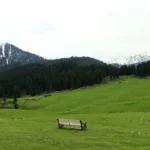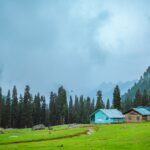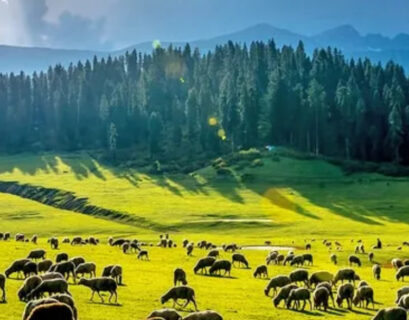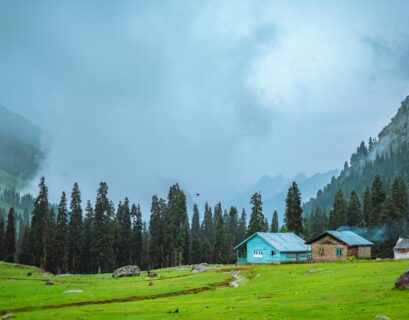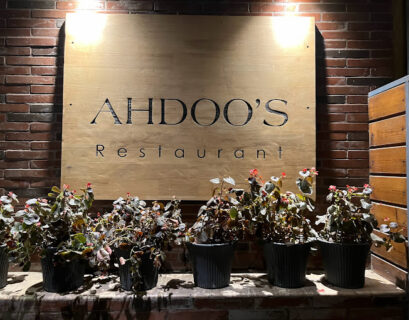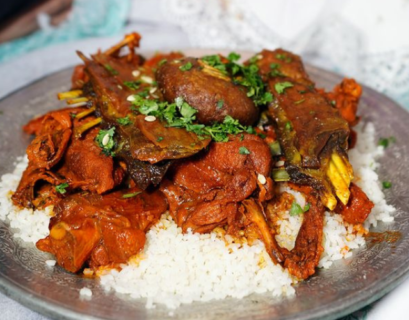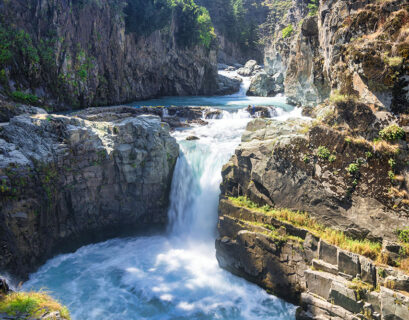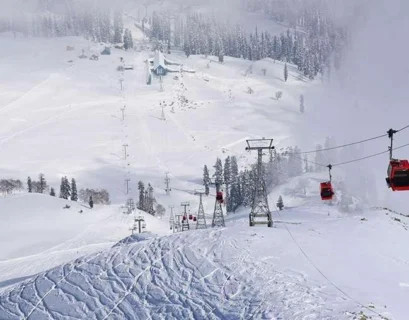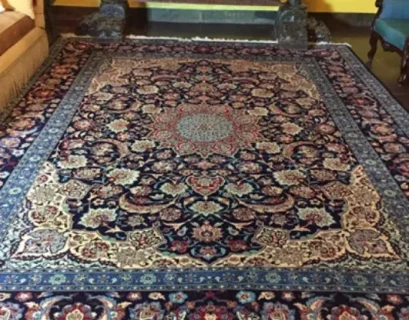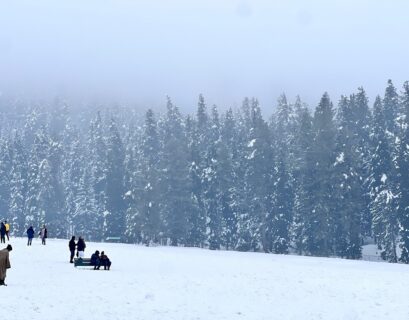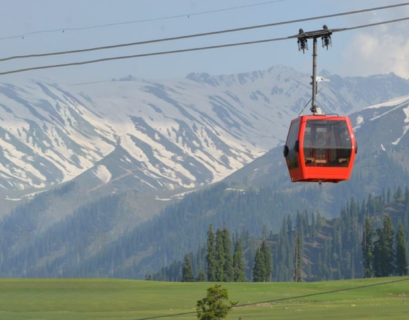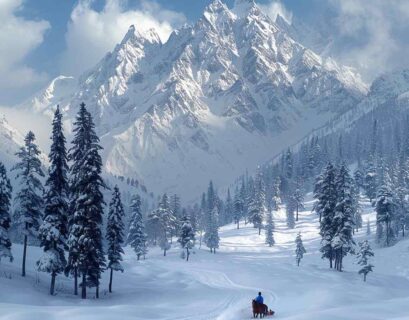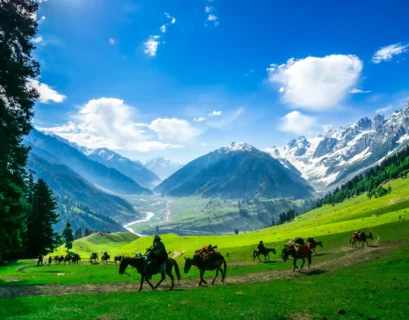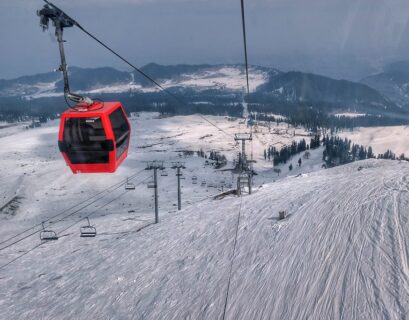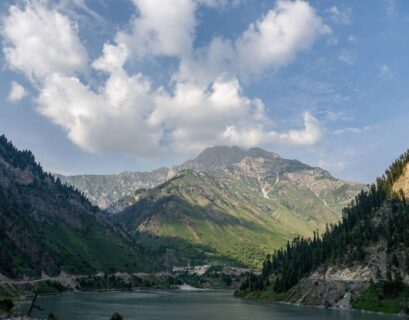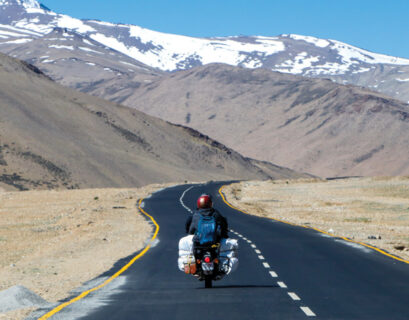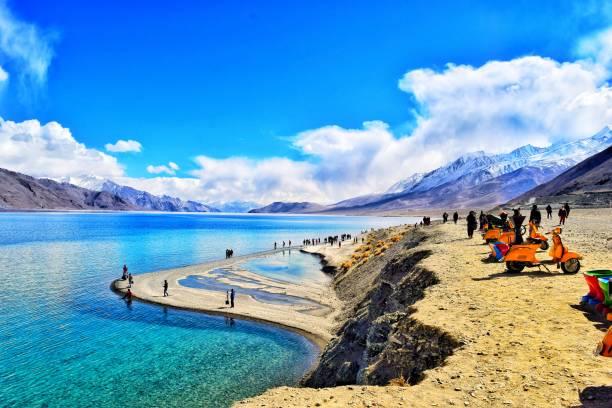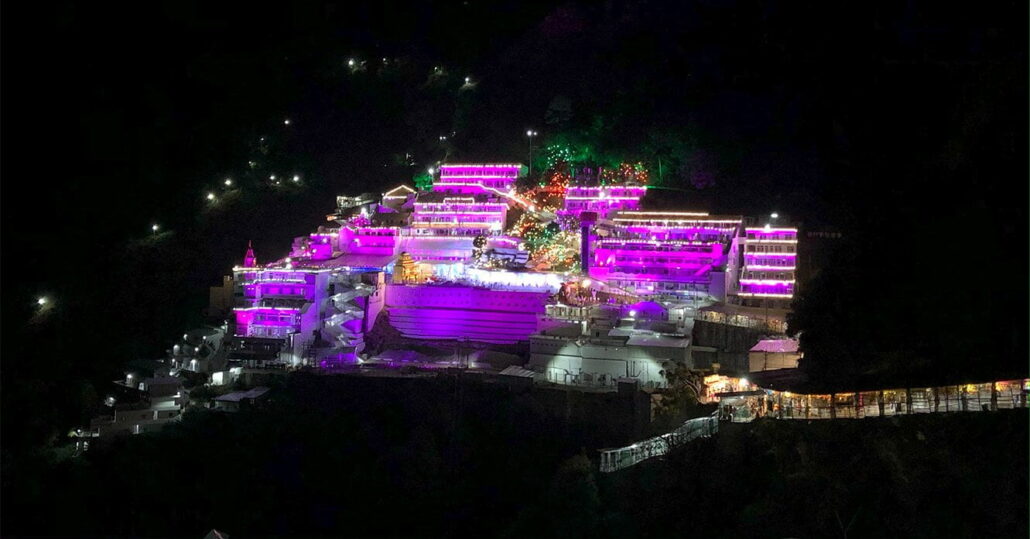The Bangus Valley official name Bungus Valley is located in Kupwara District of Indian Administered Jammu and Kashmir. It is West of Handwara town . It is situated in the Pir Panjal range and is known for its breath-taking natural beauty, including snow-capped mountains, lush green forests, and crystal clear streams. It has got two ways, one from Kupwara side which is 42 kms away from main town Kupwara and other from handwara side which is 29 kms respectively.Both the roads are almost completed.
There is an astonishing expansiveness about Bangus Valley, Jammu and Kashmir that has been referred as part of the Himalayas range. It indeed forms breathtaking beauty, silent tranquil surroundings have often been known to term it as the “hidden paradise.” Thus a withdrawal from the hustle of their schedules and din of urban existence attracts tourists towards such abodes like magnet.
It is a rich picturesque landscape of green meadows, dense forests, and crystal-clear streams, which attracts trekkers, nature lovers, and adventure enthusiasts to this land. Diverse flora and fauna with diversified wildlife make it a haven for eco-tourism as well as photography.
The area is rich in local culture and therefore presents warm hospitality in the surrounding communities. Locals can introduce visitors to life and the traditional Kashmiri cuisine and craftsmanship representing heritage at this region.
This tourist destination is attracting all and sundry to reach for the discovery of more unexplored areas to the valley of Bangus so that it will add beauty for tourism with great significance placed on sustainable tourism not spoiling its untouched, scintillating scenic beauties of nature. Beautiful scenery and the abundant heritage of culture give scope to relish the unforgettable episodes of adventure and tranquility while searching for some secluded calm places in Kashmir by these tourists.
Important Points to Know
Bangus Valley forms the Northernmost region of Kashmir, a state situated in India and falls within the Kupwara District. To go to Bangus Valley, the first thing you would do is to fly to Srinagar city, the summer capital of Jammu & Kashmir. Srinagar is easy to go via air, rail and road. After arrival at Srinagar you will be able to take taxi or get a local vehicle and proceed to Kupwara located at a distance of approximately 95 kilometers from Srinagar. After reaching Kupwara, Bangus Valley is nearly 35-40 kilometers away, much of which the road is roughly undeveloped, thus it is better to get a local guide or driver who already knows how the route looks like. The ideal period to visit this place is from late spring to early autumn as the temperatures then are more conducive for travel.
The Bangus Valley experiences a temperate climate with marked seasonal differences. The valley’s temperature ranges between 15-25°C in the summer season from May to August, thus, creating suitable and cool weather for the guests. During this period, the valley receives so much rainfall, and it is on the greener side which favors activities such as trekking and picnicking. However, In winter (December to February), the weather persists and temperatures often considered extreme are experienced. Temperatures can fall to a range of -10°C to -15°C and there is snow everywhere in the valley. There is a pleasant moderate climate of around 5°C to 15°C in spring (March to May) and fall (September to November) seasons thus these periods are best for sightseeing and appreciating the beauty of the area.
The climatic conditions in the Bangus Valley change from season to season. Looking at the gauze of the temperature variation curve during the summer months, it is often observed that the temperatures are enjoyable and accompanied by cool breezes as well as clear blue, making it a good time to undertake various outdoor activities. The valley is enveloped in greenery, with flowering plants and shiny landscapes adorning the view. In winter, heavy falls of snow cover the whole area creating a quiet and beautiful picture of snow all over the ground. This season also comes along with biting cold and terrible weather which affects the travel patterns since the roads may not be passable because of very low temperatures. Most of spring and autumn are characterized by gentler climates with reasonable temperatures and few clouds in the sky which is an excellent period to see the changing colors of the valley and the splendor present in the region.
LOCATION OF BANGUS VALLEY
Bangus valley lies in the state region, Jammu and Kashmir; it is in Kupwara district. There lie in the northern part of Himalayas, just about approximately 30 km NW of the town of Kupwara. It forms an outline of the valley dominated by emerald mountains. There is a mean height of an about 2,500 m above sea level.
Visitors have to take a scenic route that connects major cities like Srinagar through road and trekking in some areas to reach the Bangus valley. Its seclusion is untouched and serene, which is a big attraction for nature lovers and adventure seekers.
HOW TO ACCESS BANGUS VALLEY
Access to Bangus Valley is both by road travel and trekking, thereby making it a little out of the beaten track, but all the more rewarding for the visitor seeking nature's glory. Here's a broad outline of how to reach the valley:
i. Road Travel
Take-off: The nearest major town is Srinagar, the summer capital of Jammu and Kashmir, approximately 100 kilometers from the valley of Bangus.
Road Travel: From Srinagar the road travel to Kupwara is about 80 kilometers and takes about between two to three hours through roads that are not even good at times.
From Kupwara: Once at Kupwara, the drive next would be towards the valley for another 30 kilometer, which would prove to be a pretty nasty road.
ii. Trekking
The main mode of access to Bangus Valley after reaching the nearest road point is trekking. The most common route of trek starts from Reshimeal village. A trek can take anywhere between two hours depending upon the trail and pace chosen.
Best Time: The best time to visit Bangus Valley would be summer time during the months of April to September. Winter snow can sometimes make some routes impassable.
Local Guides: The local guides will help to understand the culture and the history of the region a little better and ensure one's safety while on trek.
The trek is really a challenging one, yet the beauty of the Bangus Valley landscape, in this case, soothing, speaks volumes and gives someone ample reasons to be content about having discovered this little secret in Kashmir.
FOOD IN BANGUS VALLEY
Food in Bangus Valley mirrors the rich culinary heritage of Kashmir, with diversified flavors and aromatic dishes. There are several local specialties to be found in the valley, which reflect the agricultural bounty and cultural heritage of the region. Some notable aspects of the cuisine include:
i. Wazwan: This traditional multi-course meal in Kashmir is sometimes made up of Rogan Josh (spiced lamb), Yakhni (yogurt-based meat dish), and Dum Aloo (spiced potatoes). It is an important component of Kashmiri hospitality, in fact, is one of the most significant features of Kashmiri weddings and other special events.
ii. Kashmiri Rice is considered a staple of any cuisine in Kashmir, normally, it is served together with a variety of dishes both meat and vegetable; though it is prepared differently every other time, sometimes it might include saffron, and spices.
iii. Local vegetables come from the agricultural activity undertaken in the valley: which are fresh and use as a source for various simple yet deliciously made vegetable dishes. Seasonal leafy greens, turnips, and carrots were mainly used.
iv. Must try Noon Chai, which is the salt tea and Kahwa, which is the sweet, spiced tea. Kahwa is particularly famous, made up of green tea, almonds, and cardamom, a comforting drink for the winter months.
v. Street Food: You can find some local street food here that is popular among tourists like Samosas and Paneer Tikka.
vi. Dairy Products: It plays a significant role in diet, and many dishes use dairy products such as yogurt and butter.
Eating in Bangus Valley is a delightful look into Kashmiri culture: the meals often shared with warmth and hospitality. From home to small eateries, visitors can enjoy the authentic flavors of this region.
ATTRACTIONS IN BANGUS VALLEY
Bangus Valley lies in the scenic area of Jammu and Kashmir, where the environment is calm, and the landscapes are superb. Some of the locations that need to be explored while one is at Bangus Valley are:
i. Bangus Lake: Picturesque and pristine, this glacial lake surrounded by a meadow makes the best place for a picnic and photography.
ii. Meadows of Bangus: This large area of meadow provides great scopes for setting up campsites and trekking trails, in which people enjoy nature mainly in summers when flowers begin to bloom.
iii. Kund Malhar: It is not a very distant place so popular for its majestic view and grassy land many trekkers love to visit.
iv. Ratti Gali Lake: Ratti Gali Lake is a little far from Bangus, and this is a place of some stunning glacial Lake very famous and known for the blue light water and mountain ranges.
ACTIVITIES IN BANGUS VALLEY
There are infinite things a person can indulge in Bangus Valley to get proper appreciation of the natural as well as cultural beauty of the region. Such includes:
i. Trekking and Hiking: There are quite several trails which cross some of the most beautiful sceneries and help to start trekkers or trekkers who take this valley or mountains forward in trekking and hiking through the same.
ii. Camping: Most of the tourists are there and camp in green peaceful meadows with vistas of starry night skies and sounds of nature.
iii. Photography: This valley is heaven for photographers. The view is spectacular. The colorful meadows are a photographer's paradise and the picturesque lakes offer ideal photography scopes.
iv. Fishing: Lakes and streams have given an opportunity to go fishing mainly for those anglers who enjoy angling in serene surroundings.
v. Nature Trek: It would be pretty laid back as it would traverse through the meadows and lakeshore. In reality, it would provide the tourists with information about the local flora and fauna.
vi. Wildlife Observation: It will be a lovely affair that will consist of bird watching and wildlife viewing, especially for nature lovers.
vii. Culture Encounters: The inclusions by the local communities would make them aware of inner details regarding the culture, their traditions, and their cuisines of Kashmir.
viii. Picnicking: It can be done in meadows or lakes and one will have fresh air and lovely surroundings all around.
ix. Adventure Sports: There might be paragliding or mountain biking in some areas, and it is good for the ones who are interested in those activities.
x. Horse Riding: Horse riding along the valley is another most preferred way to see the area and enjoy the landscape.
All these activities make Bangus Valley a destination that appeals to nature lovers, adventure-seekers, and peace-seekers as well.
BEST TIME TO VISIT BANGUS VALLEY
The best season to visit the Bangus Valley is summer, which falls between May and September. Here's what one expects from the climate in such a period.
i. April to June: It enjoys pleasantly warm weather coupled with slight to moderate cool temperature scales. This remains the perfect period for trekking and camp activities, as well as other outdoor activities, considering that these meadows are actually covered in rich wildflowers.
ii. July to August: Temperatures are on the rise during these months, while this is also the month of monsoon. It makes the whole valley lush green with plenty of beauty, but expect sudden rains which can make most trails muddy.
iii. September and October: It will be cool but friendly during afternoons. The landscape will get a different beautiful setting as fall colors begin to show up. Relatively not crowded, it would make much more of an ideal get-away to be very peaceful.
iv. November to March: The winter season is relatively quite cold with the possibility of snow that can make access to such areas very challenging. If one has an interest in ice sports or in the look and feel of an area white with snow, then winter might be the appropriate season time; however, one needs to prepare for below-freezing temperatures.
Probably, late spring to early fall would be the best time.
PHOTOGRAPHY IN BANGUS VALLEY
Bangus Valley allows wonderful photography with the breathtakingly beautiful landscapes, brilliant flora, and local cultures. Here are some great ideas of what you do when you go for a shoot:
i. Landscape: These are the best landscape pictures of rolling meadow stretches, mountain ranges and placid lakes. Most interesting light is there before and after sunrise, dusk being the best.
ii. Wildflower Close-ups: The meadows are all wildflowers and quite colorful. These make good shots for macro photography. Take a close shot of them and get their details and textures.
iii. Portraits with Green Background: Use the scenery to have a background for your portraits. Be shooting friends, family members, or local residents; it would give images depth.
iv. Wildlife Photography: Carry a zoom lens to capture the local wildlife and birds. Normal best time for the photographing wildlife is the early morning time.
v. Candid Shots of Local Life: Photographing local villagers and their crafts depicting culture and way of life existing in that area.
vi. Shots of Sunrise and Sunset: The golden hours cast magical lighting conditions. Shot the changing colors of the sky over mountains and lakes.
vii. Adventure Activities: Document trekking, camping, and other adventure activities. Action shots add excitement and energy to your portfolio.
viii. Astrophotography: With clear and unpolluted skies at night, the Bangus Valley is perfect for star photography. Use a tripod for long exposures.
ix. Water Reflections: Lakes have very still waters. It can be used for creating mirror-like reflections. Some stunning compositions.
x. Seasonal Changes: If you visit at different seasons, capture the landscape changes-from vibrant greens during summer to snowy scenes during winter.
These ideas will help you make the most out of your photography experience in Bangus Valley, capturing its beauty and essence from various angles.
WHERE TO STAY IN BANGUS VALLEY?
There are places to stay in Bangus Valley, though they come in different forms. A few of these include campsites, where most individuals go to camp in the grasslands. You can camp here in the designated camps, which will expose you fully to the effects of nature.
i. There are a few guesthouses and lodges in the place that have very basic facilities, though it could be arranged in advance when one finds that such an option is less available to be visited during the peak season.
ii. Some local family may allow the homestay for an incredible experience with food and local traditions. The rest house or bungalow, for that matter sometimes known as Government run bungalow/ rest house may also provide options to the tourists
iii. There will not be many resorts exactly in Bangus Valley, however, you will come across a few in areas like Gulmarg and Srinagar. Resorts are also there to live relatively luxuriously without much bother if you agree to travel a bit.
Booking well ahead and making a reservation is advisable. During the peak season, bookings are filled within a very short time.
SAFETY TIPS AND TRAVEL ESSENTIALS FOR BANGUS VALLEY
When traveling to Bangus Valley, it is important to note safety and prepare for travel. Here are some travel essentials and safety tips.
Safety Tips
i. Check weather conditions: Before traveling check the weather forecast since these conditions can change fast within a short period. Mountains are known to have erratic weather conditions.
ii. Go together as a group: Traveling as a group gives comfort, security, and support during lonely nights. It risks very little since there is sure one there to back or advise when necessary in dangerous terrain.
iii. Travel on a road or trail: That leads to the correct and a relatively safe place avoiding detours and other off trail wanderings.
iv. Hydrate and Rest: Drink enough water and rests, especially if you are trekking to avoid getting tired and dehydration.
v. Basic First Aid Kit: Pack a small first aid kit in case of minor injuries and any personal drugs that may be required.
vi. Respect Local Customs: Be respectful of local traditions and customs especially when dealing with residents.
Travel Essentials
i. Dress in layers: Dress according to the temperature that is expected to change. The outer layers should be waterproof and windproof.
ii. Comfortable Footwear: Try to carry sturdy hiking boots for trekking and moving on uneven terrains.
iii. Backpack: It is always required to have a good backpack to carry your essentials at the time of hiking.
iv. Water Bottle: Refillable water bottle to have water always with you on the hike.
v. Food and Snacks: Nuts, fruits, energy bars, even chocolates and cookies are allowed for boosting energy in any long treks. A pair of binoculars to have handy when photographing wildlife or viewing animals.
vi. A map or GPS device: If you don't have good mobile service in the countryside.
vii. Sunscreen, sunglasses, and a hat: For protection against sun exposure
viii. Flashlight/Headlamp: In case you plan to camp or hike at dawn or dusk.
ix. Cash: Although not too many areas have ATMs, it's really handy for small buying activities.
Using these safety tips in mind and having all the right essentials with you, you'll certainly have more fun in Bangus Valley!
PERMISSION REQUIRED FOR BANGUS VALLEY
It is not possible to visit Bangus Valley without permission from the local authorities as it falls in the sensitive region of Jammu and Kashmir. Here is what you need to know about getting the necessary permissions:
i. Tourist Permit: Travelers may need to obtain a tourist permit from the local administration or tourism department. This is especially important for areas that are considered sensitive or have restricted access. Before traveling, one may always check with local tourism offices or official websites as regards the latest requirements about permits. Regulations change, and they may not be able to update their information accordingly.
ii. Travel Agencies: Travel agents specifically catering to Kashmir tourism might even take care of all permits and guide one on what is required.
iii. Identification: You will require some sort of identification, whether it be a passport or national ID. You might have to acquire permits for your stay. Join a guided tour and make it easy for you. Many guided tours have everything included in the package: all necessary permissions.
Always try to initiate the process of seeking permission pretty well in advance before your trip so that you avoid last-minute hassles. Always be alert about the latest travel advisories and requirements of the region.
RICHNESS IN NATURAL BEAUTY AND DIVERSITY IN BANGUS VALLEY
Bangus Valley, Jammu and Kashmir - one of the most exquisite and yet so untouched corners of the Indian Himalayas. It is a virgin beautiful place, with green meadows and snow-peaked mountains of high diversity, where lovers of nature, trekkers, and wildlife could have a real experience of it. Let us discuss the beauty and diversity that makes Bangus Valley truly exceptional.
1. Magnificent Landscape and Panoramic Views
The valley has huge expanses of alpine meadows. Often considered one of the most beautiful meadows in the entire Kashmir Valley, these meadows undergo huge distances covered by bright colours of wild flowers in summer and hemmed by conifer stands and oak groves. Great to trek through or pitch your tents on for some rest and away from the clutches of noise and hoo-ha of town.
The valley is encircled by mountains which are snow-covered. The Himalayas range forms a spectacular backdrop to the valleys. The peaks are just a sight in the months of winter with glistening snow against the deep sky. The valley is blessed with a silence that sometimes is broken by the wind soughing through the trees and the distant rivers.
There are so many rivers and streams passing through the valley; this gives a very scenic and beautiful aspect to it with bright and cool water. Rivers, like Bangus River and others that are smaller add a perfect picturesque beauty in the valley-perfect relaxation spots, fishing spots or enjoying a scene.
2. Bangus Valley Flora - A Field of Wildflowers
The valley blooms into colors with wildflowers in the summer months from June to August. It includes purple crocuses and yellow primroses, red poppies and pink rhododendrons. Meadows are actually a painter's canvas to color the earth much to the delight of any nature photographer or botanist.
Rich deodar, pine, and oak forests encroach upon the valley area throwing shades and shelters for all trekkers across and providing habitancy to many species of flora and fauna. Big open green forests have emerged and opened into even green meadows; with a small geographical area, diverse ecological environment has been found.
In addition to many medicinal plants, it is also rich in many others that the local people take for curing. Medicinal plants have been known and used for the traditional healing processes in the different communities. This aspect of connecting with the valley adds much value to its dimensions between natural beauty and cultural heritage.
3. Riches in Wildlife and Biodiversity
Fauna: The fauna here is varied and rich in Bangus Valley. There are different species of mammals, birds, and insects. Some of the fauna known to be present there are Himalayan brown bears, musk deer, leopards, and wild boar. You may even find hare, foxes, and other rodent species here.
Birds paradise: It is also considered as a haven for any bird lover. Pheasant and other varieties of birds here included the eagle, partridges and the woodpeckers, along with many that fly into it for sojourns in either the spring or autumn.
It teems with colorful butterflies and insects, making it a dream destination for macro photographers. Butterflies will be swarming around the flowers during the summer seasons.
4. Unique Climate and Seasonal Variations
During May to September, the valley is totally lush green in color; here the temperature often fluctuates at times of around 10°-20°. For those people looking for places for trekking, picnicking, or pitching their camp. The place offers you its lush-greenish meadows; wild flowers start blossoming in grand glory to fill your views of beauty throughout the valleys.
October and November is when autumn peaks into its glory. The maple, oak, and several other varieties have turned a deep shade of golden-yellow, with an occasional green splattering, thus making up a color scene in perfect contrast to the white peaks above. As a photographer or a shutterbug, it is in such times of the autumn and the snow-white peaks at one's behest.
During December to March months, the valley clothes the valley deep under thick layers of snow and turns out to be a perfect wonderland. The grassy meadows altogether covered with deep blankets of snow shine with silvery frosted peaks from far, which becomes a peaceful retreat quite inaccessible by nature though. The most easily accessible months during winters despite massive challenges to accessibility owing to very heavy falls of snow. At last, these offer some of the best scenic and serene winter landscapes available in the world.
Spring in the Bangus Valley is when the nature gets revived from extreme wintering. The melting snow, emergence of flowers and greenery amidst snow-clad summits makes it picture-perfect for both nature lovers and photographers alike.
5. Adventure and Outdoor Activities
Trekking: Several trekking trails take one across the valley to view the meadows, rivers, and mountains from various vantage points in Bangus Valley. The treks can be easy or more strenuous ones.
- Bangus to Tulail Trek
- Bangus to Ratti Gali Lake Trek
- Razdan Pass Trek
Camping: The vast, open meadows and the clear skies make Bangus Valley a perfect place for camping. Whether it is for a night under the stars or multi-day camping sojourn, the valley provides silent and secluded places for contact with nature.
Fishing and River Activities: Rivers and streams of Bangus Valley are very crystal clear. They are good for fishing activities. It is said that these waters harbor trout, and indeed, it is a perfect relaxing activity for those under the sun. Along river banks, picnic areas and places for mere relaxation by water could be found.
6. Cultural and Spiritual Significance
Though the Bangus Valley is more known for its aesthetic beauty, it has also held an important cultural and spiritual relevance to the local communities. The valley is a home to a large number of grazing communities, like Gujjars and Bakerwals, who shift their cattle to the pastures during summer. This is what gives the valley its traditional and pastoral beauty.
Shepherding and life as a shepherd have a great deal of cultural meaning because the valley itself has such a long history as a place of grazing. The valley appears pastoral, too, with nomadic herders moving about with their sheep and goats, setting up temporary wooden huts in which they can rest over the summer months.
The ancient site consists of many historical and old temples and shrines that are spread over the place in the region of the Bangus Valley, while some are dedicated to various Hindu gods, others to local deities. Sacred places are excellent retreats for people who need a spiritual abode in their life amidst nature, as very often they lie atop hills or near sources of water.
7. Natural Beauty and Diversity Galore
Bangus Valley is paradise for those who do worship untouched beauty and unspoiled landscapes. With vast alpine meadows, rich forests, snow-crowned mountains, and abundant wild life, this valley is very diverse and the most beautiful in the region of Kashmir. Whether you are a nature lover, photographer, adventure-enthusiast, or a soul searching for peace, serenity, or something out of the ordinary, it's going to find all the things under the charm of natural beauty of valleys and the splendor of seasonal charm and biodiversity.
And indeed a treasure for all those offbeat seekers in all the senses of it where an authentic taste of splendor of the Himalayas will be experienced.
LOCAL CULTURE AND TRADITIONS IN BANGUS VALLEY
Not just land for natural beauty, but this is a land of rich and diversified cultural heritage-the Bangus Valley in the State of Jammu and Kashmir. Situated between the Himalayan Mountains and lush meadows of alpine heights, the valley has indigenous communities whose lifestyles have traditionally been interwoven and correlated with the land, thus its natural rhythms.
1. Indigenous Communities and Livelihoods
The culture of Bangus Valley is mainly the contribution of local communities, especially the Gujjars, Bakerwals, and Kashmiri Pandits, which have stayed in this place for centuries hence contributing to the cultural fabric of this valley.
Gujjars and Bakerwals
Gujjars and Bakerwals have been nomadic pastoralists in the valley for decades. They remain the principal pastoral communities of the valley who live by raising sheep, goats, and buffaloes.
Bakerwals take their herds to lower altitudes at winter and to alpine meadows like Bangus Valley at summer. In the language of this ethnicity, it is termed as "Kochi." Such a movement is considered essential in their tradition.
In the summer, Gujjars and Bakerwals live in tents while they let their herds graze in Bangus Valley for lush meadows. Tent is referred to as a "Kotha." It's pretty simple and effective but ideal for tent living.
Livestock contributes not only to livelihood generation but also plays a mainstream role in the social and religious life of the community. Sheep provide wool, meat, and milk for diets and economies at the locality level. The herder regularly makes cheese and butter from the milk of his cattle as it constitutes a significant segment of his diet.
Kashmiri Pandits and Settled Communities
Traditionally, the Kashmiri Pandits settled in the valleys of Kashmir and many communities can still be seen on the periphery of Bangus Valley. The Pandit communities have added to the cultural flavor of the valley mainly in the realms of spirituality, music, and art. Though many have migrated out of the region as a result of political troubles, yet many still sustain close affinity with their country.
2. Language and Folk Traditions
Language
The predominant language of speech in the Bangus Valley is the Dardic language called Kashmiri, it heavily has Persian and Sanskrit influences. This is simply because for a long period, social relations have been prevailing in this part of the world.
Gujjars and Bakerwals also converse in their unique dialects: Gujjari and Bakerwali in similarity to Pahari dialects of other parts of Jammu and Kashmir as well as the Northern districts of India.
Traditional Music and Dance
Folk music related to cultural identity makes Bangus Valley famous. Their traditional songs usually are performed through simple musical instruments, often including a "sitar", "dhol", "nishan" flute, and "rabab" strings.
In this region, dances like "Rauf" and "Bhand Pather," a Kashmiri folk dance and theatrical performance, prevail on festivals and other celebrations. The dances and music present a story for the expression of community affinity with the natural world and spiritual ideology.
Traditional songs and poetic expressions also feature in Kashmiri culture. This includes songs like Ghazals that talk about love and Sufi poetry that discusses love, mysticism, and nature.
3. Festivals and Religious Activities
Bangus Valley is the place where different religion practices are happening there, such as Islam, Hinduism, and Sufism, and for this reason, their festivals and religious activities are also witnessed here.
Islamic Festivals
The major festivals of the valley are Eid al-Fitr and Eid al-Adha, which are the greatest celebrations of the Muslim community. On Eid, prayers, congregations, and celebrations reverberate all over the valley. The villages are bedecked with colorful flags, and people visit each other's homes to extend greetings and gifts.
Mawlid al-Nabi or the birth of Prophet Muhammad(PBUH) is another religious observance with special prayers, congregations, and community celebrations.
Hindu Festivals
Shivaratri is night-long prayers and rituals by the Kashmiri Pandit community. Though very fewer in number today, their celebration is an epitome of deep-rooted Hindu spiritual traditions in the valley.
Navratri and Diwali are observed along with traditional prayers, dances, and rituals.
Sufi Traditions and Festivals
Sufi shrines make the skyline of Bangus Valley. There are more locals coming for seeking favours at the shrines of Sufi saints. Generally speaking, those places would normally be placid in an atmosphere naturally set up; significance involves the mystique and aura of spirituality which is ascribed to the valley.
The Urs (death anniversary) of Sufi saints is performed with special prayers, congregations, and celebrations. Devotional music and dances are performed in reverence to the saints and in the hope for spiritual favors.
4. Cuisine and Traditional Food
The Bangus Valley cuisine depicts Kashmiri food culture and its nomadic and settled cultures in their lifestyles among the Gujjars and Bakerwals.
Local Cuisine
A traditional Kashmiri feast known as Wazwan very well depicts the culinary heritage of the valley. Rogan Josh, Yakhni, Gushtaba, and Kahwa, a spiced green tea brewed with saffron, cinnamon, and cardamom, are the most distinguishing elements of Kashmiri cuisine. All these dishes are basically prepared using lamb or mutton, which is abundantly consumed in the valley.
Dairy consist of milk, curds and cheese form part of it except for the above-mentioned routine dishes: saag and kahwa tea.
Traditions in their Modes of Cookery
Many families in the valley are still cooking food through clay ovens, tandoors, and large handi pots. In traditional food preparation, this is usually a social activity since people gather to assist one another in cooking and feasting.
5. Architecture and Art
Traditional Architecture
The valley architecture is Kashmiri and Islamic. Wooden houses are made from cedar and pine woods and carved excellently with ornaments. Gujjars and Bakerwals' houses are somewhat simple as they live nomadic lives and are hence practical.
Mosques and temples are some of the prominent cultural signs in the valley, their architectural styles reflecting spiritualism in the region.
Handicrafts
The most popular ones are Kashmiri carpets, Pashmina shawls, and papier-mâché crafts. This is not a case of commercialization in the valley itself. The old skill is still surviving among small communities of local craftsmen who hand it down to the next generations.
Location of BANGUS VALLEY Jammu and Kashmir in Google Maps
People Also ASK about Bangus Valley
What is Bangus Valley famous for?
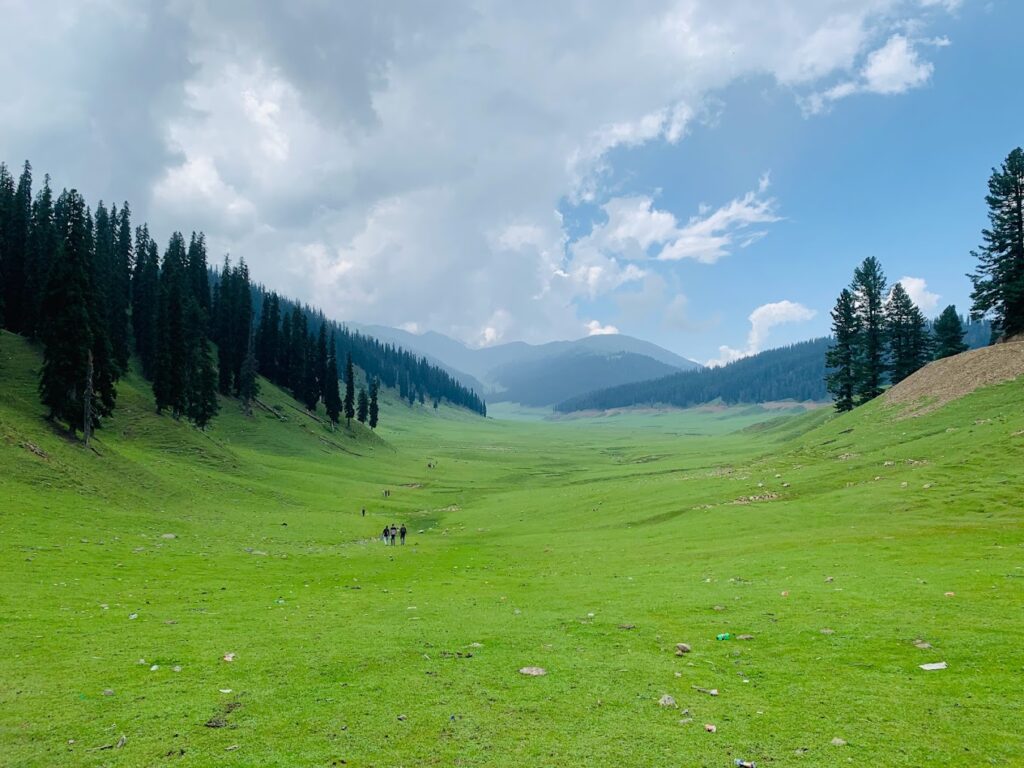
Bangus Valley is a place in the state of Jammu and Kashmir, very famous for its scintillating natural beauty along with serene environmental conditions. The valley has beautiful lush green meadows, dense forests, crystal-clear water bodies, and snow-covered ranges to include on the list of Kashmir region’s hidden gems. It possesses a good amount of biodiversity as this place has various forms of wildlife and medicinal plants. The valley is equally famous for trekking. The trails in this valley are both scenic and less crowded. It has old Kashmiri villages, along with the moderate summer and snowy winter climate, making it a tourist spot round the year.
Is there any permission required for Bangus Valley?

Yes, You need permission from the authorities before visiting Bangus Valley because it is a protected area in Jammu and Kashmir. This area is relatively remote and falls within a sensitive zone, thus requiring tourists to have permits for their safety and regulation in visiting the said area. Permits are requested from district administration or local governments for entry. Furthermore, if you are planning a trek or visit to protected areas in the valley, you might also need clearance from the relevant forest or tourism departments. It is always a good idea to check with local tourism offices for the current regulations and instructions before even planning a visit.
Which district is Bangus Valley in?
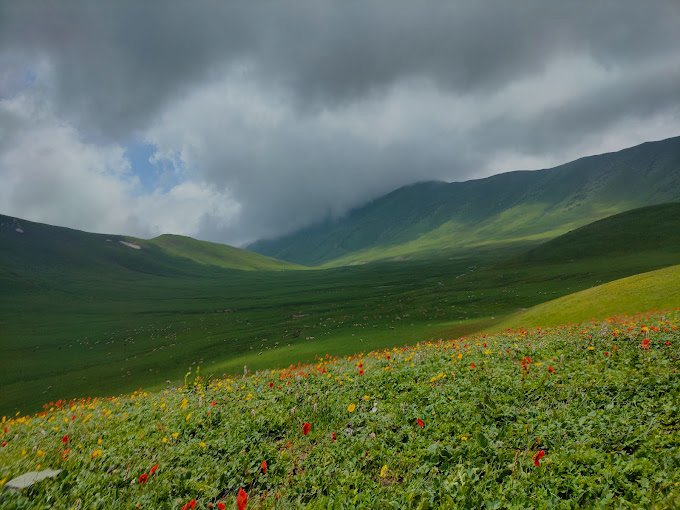
Bangus Valley is located in the Kupwara district of Jammu and Kashmir, India. The valley is situated in the northern end of the region with great scenic beauty, dense forests, and intact environments. Kupwara is also popular for its greeneries, mountaineous areas with heavy snowfall, and peaceful surroundings. This district includes one of its most beautiful and untouched areas, Bangus Valley, that has been another quiet retreat for all nature lovers and adventure seekers. It is relatively remote from the rest of the district and less commercialized than others in Jammu and Kashmir.
Is there water in Bangus Valley?
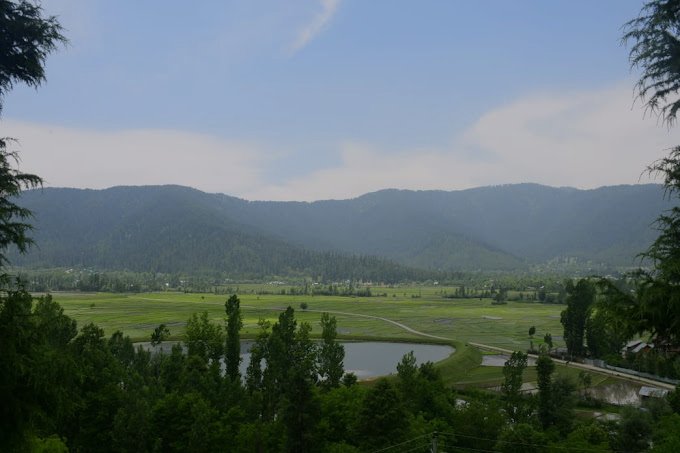
Yes, there are a number of water bodies which undoubtedly add to the beauty of Bangus valley. The sparkling streams, crystal-clear rivers, and freshwater springs traverse through the lush meadows and dense forests within the valley, adding the region’s vivid visual beauty. Water sources must have created a serene atmosphere for the visitors. The presence of water also supports diverse flora and fauna and hence adds to the rich biodiversity of this valley. During summer, they are greatly refreshing; during winter, they may freeze due to the cold temperature, thereby creating a really beautiful sight of snow. Overall, water is an integral part of the charms of Bangus Valley.
Is camping allowed in Bangus Valley?
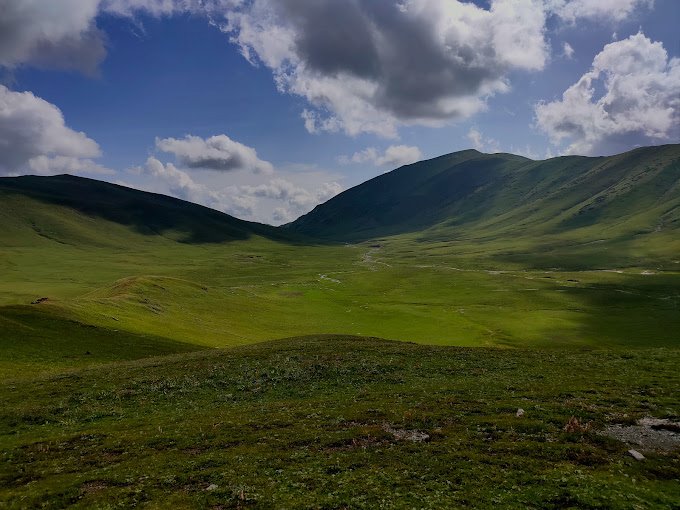
Yes, camping in Bangus Valley is permitted and is one of the popular activities for nature and adventure lovers. The remoteness of the valley coupled with its scenic beauty creates a serene ambiance that is perfect for camping. Visitors can pitch their tents in the designated areas enjoying lush grasslands, clear streams, and snow-covered peaks. Since it is a protected and sensitive area, the tourists should acquire all permits from the local authorities before camping. Eco-friendly practices should be practiced in order to preserve the valley’s pristine environment. The experience of camping in Bangus Valley is that of a unique yet peaceful experience amidst nature.
What is the altitude of Bangus Valley?

Bangus Valley is situated at about 2,500 meters (8,200 feet) above sea level. Such a position contributes to its cool climate, thus making it a perfect destination for nature lovers and trekkers. The valley has snow-capped peaks surrounding it, and the altitude makes sure that the area is left untouched by heavy commercialization, preserving its natural beauty. The elevation also affects the valley’s unique flora and fauna, with a variety of plant species and wildlife flourishing in this type of high-altitude environment. The altitude makes Bangus Valley an ideal trekking destination, offering adventure and tranquility alike to its visitors.
How to reach Bangus?
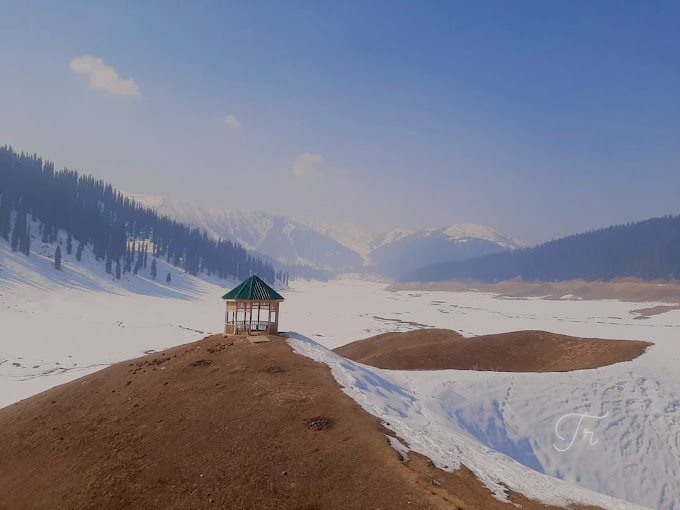
To reach Bangus Valley, one needs to first land in Kupwara, which is the nearest town in Jammu and Kashmir. Kupwara is connected by road to Srinagar, about 90 kilometers away, which has an airport with domestic flight connections. From here, the valley is accessible by road, but it is a remote and lesser-developed area, so it requires a sturdy vehicle, preferably a 4×4. The final stretch of the road is tough, and it is even more challenging during winters. It is better to hire local guides to assist, as well as obtain necessary permits prior to reaching the valley.
Is Bangus Valley worth visiting?

Yes, Bangus Valley is worth visiting without a doubt. The valley boasts of breathtaking scenic beauty with lush green meadows and crystal clear streams as well as dense forests and snow- capped peaks. This is a treasure-hunt spot in Jammu and Kashmir, hidden from the rest of the tourist spots due to its peaceful atmosphere, rich biodiversity, and serene environment. One can trek and camp in these beautiful valleys as they offer scenic trails and adventure opportunities. With unspoiled landscapes and traditional Kashmiri villages, Bangus Valley remains relatively less commercialized in order to ensure a pure nature experience for the visitors. This is a must-visit destination for all nature lovers and adventure seekers.
Bangus Valley distance from Srinagar?

Bangus Valley is about 90 kilometers (56 miles) from Srinagar, Jammu and Kashmir summer capital. The drive from Srinagar to Kupwara, the nearest town to the valley takes about 2 to 3 hours depending on the road conditions. From Kupwara the valley is about 25-30 kilometers away. It would take an additional journey of about 1 to 1.5 hours depending on the terrain. The track is comparatively narrow and twisty; one needs to have robust automobiles, especially in the winter season when it could become slippery and impassable due to snow. It is always safer and more convenient to tour with a local guide.
External Links about Bangus Valley
External Links to More resources related to BANGUS VALLEY, Jammu and Kashmir
Here are a few resources that can help you learn more about Bangus Valley:
1. Jammu and Kashmir Tourism (Official Website)
-
Website: https://www.jktourism.org
-
Details: This is the official tourism website of Jammu and Kashmir. It provides general information about the valley, including popular tourist spots, travel tips, and more. Bangus Valley is often featured in broader content about Kashmir’s natural beauty.
2. Kashmir Valley Tourism (Unofficial Travel Guide)
-
Website: https://www.kashmirvalley.com
-
Details: This website offers detailed information about the entire Kashmir region, including Bangus Valley. It discusses attractions, trekking routes, and eco-tourism opportunities, which may be helpful for travelers interested in exploring the area.
3. TripAdvisor (Travel Reviews & Insights)
-
Website: https://www.tripadvisor.in
-
Details: Search for Bangus Valley on TripAdvisor for reviews, travel tips, and photos from visitors. This platform provides insights on accommodations, tours, and activities in the region, along with ratings from other travelers.
4. The Kashmir Monitor
-
Website: https://www.thekashmirmonitor.net
-
Details: A regional news website that often covers topics related to tourism, developments, and environmental conservation in Kashmir. Occasional articles may feature stories on Bangus Valley.
5. Kashmir Tourism: Incredible India (Government of India’s Tourism Website)
-
Website: https://www.incredibleindia.org
-
Details: This official site promotes tourism across India, including the Kashmir Valley. It offers details about popular tourist destinations, including offbeat spots like Bangus Valley.
General FAQs
Yes – The valley is accessible via road from Srinagar, although the roads can be challenging due to weather conditions, especially in winter.
No – Public transportation options are limited, and it is recommended to hire a private taxi or jeep for better access.
No – While it is accessible during summer months, winters can block roads due to snow, making it inaccessible from November to March.
No – There are no major hotels in the valley, but travelers can find basic guesthouses or opt for camping.
Yes – Camping is allowed and is a popular activity, with various sites offering picturesque views of the valley.
No – There are limited food options, so visitors often carry their own supplies or depend on local villagers.
Yes – The valley is generally safe, but it's advised to travel with a guide, especially during the winter months or if unfamiliar with the terrain.
Yes – It is possible, but hiring a local guide is recommended to enhance the experience and ensure safety
Yes – The valley is known for its scenic trekking trails, attracting adventure enthusiasts who love exploring nature.
No – The mobile network is often weak or unavailable in most parts of Bangus Valley, so it’s advisable to prepare accordingly.
No – There are no established medical facilities in the valley, so visitors should carry first aid kits and any essential medications.
Yes – It’s a great place for families, though one should take necessary precautions, especially with children, due to the rugged terrain.
No – Due to heavy snowfall and cold temperatures, it’s not advisable to visit during winter unless prepared for extreme conditions.
Yes – Bangus Valley is part of a conservation effort, and tourists are encouraged to respect local wildlife and natural resources.
Yes – The valley is home to diverse wildlife, including deer, musk deer, and various bird species.
Yes – The breathtaking landscapes, lush meadows, and snow-capped peaks make it a photographer’s paradise.
Yes – It boasts rich biodiversity, including alpine meadows, forests, and rare plant species.
Yes – A permit is required for non-local tourists, and it can be arranged through local authorities or tour operators.
No – The valley is primarily known for its natural beauty and is not a hub for cultural landmarks, though local Kashmiri traditions are present.
Yes – The serene beauty of the valley makes it an ideal romantic getaway for honeymooners looking for peace and nature.
No – The valley itself does not host large festivals, but local villages may observe traditional festivals.
Yes – Fishing is allowed in some areas of the valley, though regulations should be checked with local authorities.
No – Due to its remote location, internet access is generally unavailable, making it a perfect place to disconnect.
Yes – Trekking gear can be rented in nearby towns or Srinagar, but availability in the valley itself is limited.
No – There are no formal markets, but small villages may offer local crafts and handmade goods. Visitors can purchase souvenirs in Srinagar before heading to the valley.


